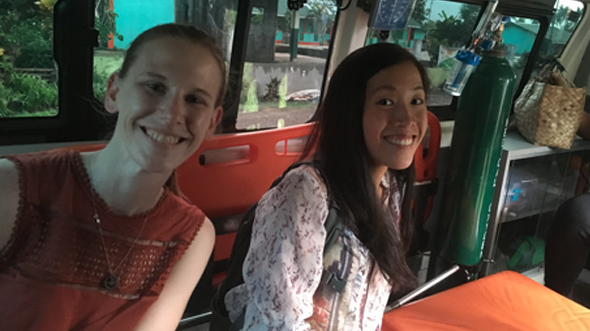It sounded straightforward. A trip to the Philippines to interview and photograph people for Family Planning Voices, our storytelling initiative with USAID and FP2020, in which we share the experiences of men and women from around the world who are passionate about family planning. But getting there was far more challenging than we could have imagined.
During the two-week trip, two of my Knowledge for Health (K4Health) colleagues and I visited three provinces (Bohol, Oriental Mindoro, and Iloilo) in addition to Manila. To reach those rural areas far from the capital, we rode on almost every form of transportation imaginable. Not for fun, but out of necessity. Let me give you the full picture.
On June 2, we started the day in Tagbilaran City, on the island of Bohol. We caught a 6:30 a.m. flight to Manila where, upon landing, we jumped in a van to take us to the ferry. Once we disembarked in the city of Calapan in the rural Oriental Mindoro Province, we took a shuttle, a motorized tricycle (!) and a bus until we finally reached the day’s destination of Baco around 2 p.m. After interviewing and photographing a lively advocate and two inspiring midwives at the Baco Municipal Health Office, we realized that the bus back to Calapan was no longer running. So what did we do? We took an ambulance back to town, the only vehicle going our way.
The next day, we had a slightly shorter trip, but a much more rural one. If our trip inland to the center of Baco was long, our trip to Pulantubig and San Andres, two small fishing communities near the coast, was winding. The roads were small and largely unpaved. Our driver explained that during the rainy season, the chances we would have reached Pulantubig would have been slim at best.
After the trip, I began putting this into perspective: When community health workers distribute contraceptives and other supplies in these areas, they follow some of the same routes we took. What if it is too rainy or muddy for them to travel? Do women have to travel those roads themselves or else go without contraception? Or do they have to hope they can catch a ride on an ambulance to get their contraceptive shot or pack of birth-control pills? And what about long-acting family planning methods? Those are basically out of the question when the nearest health facility is hours away and the journey is so challenging.
One of the family planning clients I interviewed in Pulantubig said that she usually doesn’t have trouble getting her contraceptive shot, which her community health worker provides to her every three months. However, sometimes she has to go into town to get it at a clinic. Having myself ridden from Pulantubig “into town,” along those windy and bumpy nausea-inducing roads, I know what a burden that must be for her. But this is the reality for thousands of women in the Philippines – and millions around the world – who need better access to contraception.
Providing essential contraceptive services to women and their families is not only a health issue. It is about infrastructure, adequate supplies, and supportive policies for community health workers in rural areas. During my many hours of car, plane, ferry, van, and other rides during those two weeks, I had a lot of time to think. I realized just how important it is to look at family planning holistically. Only when all these systems can come together will we truly be able to provide access to the 214 million women with an unmet need for modern contraception.





